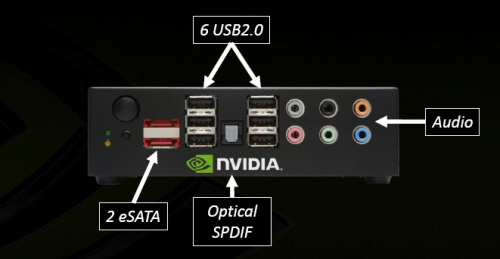A teeny-weeny box. Ding, ding: ION versus Yukon for 2009
A teeny-weeny desktop box
Coming back to ION, here's the reference platform built into a small chassis. Now, ION makes just as much sense, if not more, as a cheap desktop solution, especially if Intel ramps up production of dual-core Atom 330s quickly.
As a small, quiet, cheap multimedia box, ION and dual-core Atom would be a good fit. The Pico-ITX platform has provision for HDMI and 7.1-channel LPCM sound, of course, and a box that's comfortably smaller than three DVD cases stacked together sounds rather appealing.
NVIDIA's also keen to point out that GeForce 9400M, ostensibly a graphics chip, could also help with high-def. transcoding, and internal benchmarks show it to be 5x faster than the Atom CPU alone.

What we think
Intel's Atom has been a shot-in-the-arm for the mobile space because its introduction has allowed partners to bring extremely thin-and-light notebooks (ahem, netbooks) to market at low prices. These ultra-mobile laptops have caught the public's imagination but, now, we believe, users are clamouring for more performance. It seems that both AMD (with Yukon) and NVIDIA (with ION) are in agreement on this front.
NVIDIA's solution for a do-it-all netbook takes in GeForce 9400M and builds around it. We like the basic technology, but readers must be aware that the provision of extra power- much-needed in our opinion - will come at a greater financial and spatial cost. Expect these kind of netbooks to cost £350+ and ship with larger screens, optical drives, bigger batteries and, of course, heavier weights.
Building on the success of Atom, we further believe that a significant market opportunity exits for a ~1.5kg netbook that has graphical/multimedia grunt to burn, and ION seems like a good fit, on paper at least.
More intriguingly, we see ION fit better into a 'nettop' environment, housed in a small box that ships with an SSD drive and passive cooling. Mini-HTPC springs to mind, too.
We can only pass judgment once retail examples become available. Hopefully that shouldn't be too long after the showcase at CES 2009, and we'll update this article with any new information that we glean in the intervening period between announcement and product.
Fundamentally, NVIDIA's ION removes the chipset limitations that have dogged the Atom platform and that can only be viewed as a good thing. What will be really, really interesting is to see how NVIDIA's ION shapes up against AMD's Yukon. Roll on 2009!






